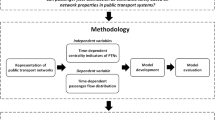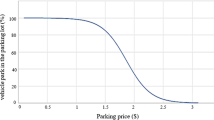Abstract
This paper investigates the implementation of a dynamic reference point scheme to capture traveler’s mental characteristics, with their day-to-day route choice behavior and heterogeneity. The traveler’s heterogeneity focuses on their different risk attitudes. On each day, travelers choose the routes based on their estimated travel costs, which can be affected by the reference point structure and its update. Most existing studies on the day-to-day traffic assignment models are proposed to capture day-to-day flow fluctuations through a learning model based on traveler’s past experience and information, but did not work on the consideration of gain and loss, which is described by the reference point scheme, comparing with traveler’s previous experience. This study aims to develop a day-to-day dynamic evolution model, in which travelers take on a tendency to refer to their previous travel experience as a reference when coping with different travel scenarios. First, the multi-class dynamic system is proposed to model traveler’s route choice behavior in a transportation network with two traveler classes. Then, the equilibrium state and stability of the evolution model is examined. We further investigate the class-specified update structure of the reference point. Finally, numerical experiments are presented to illustrate the application of our method.









Similar content being viewed by others
References
Arkes HR, Hirshleifer D, Jiang D, Lim SS (2010) A cross-cultural study of reference point adaptation: evidence from China, Korea, and the US[J]. Organ Behav Hum Decis Process 112(2):99–111
Avineri E, Prashker J (2003) Sensitivity to uncertainty: need for a paradigm shift[J]. Transportation Research Record: Journal of the Transportation Research Board 1854:90–98
Azmat G, Iriberri N (2010) The importance of relative performance feedback information: Evidence from a natural experiment using high school students. Journal of Public Economics 94(7-8):435–452
Bar-Gera H (2005) Continuous and discrete trajectory models for dynamic traffic assignment. Netw Spat Econ 5(1):41–70
Bie J, Lo HK (2010) Stability and attraction domains of traffic equilibria in a day-to-day dynamical system formulation. Transp Res Part B 44:90–107
Bureau of Public Roads (1964) Traffic assignment manual. Tech Rep. US Department of Commerce, Washington, DC
Cantarella GE (1997) Fixed-point stability and bifurcations in dynamic processes for traffic assignment[M]. IOSS Press
Cantarella GE, Cascetta E (1995) Dynamic processes and equilibrium in transportation networks: towards a unifying theory. INFORMS:305–329
Cantarella G E, Velonà P (2003) Stability analysis of equilibrium patterns in a transportation network[C]. Proceedings of the european transport conference (etc) 2003 held 8–10 october 2003, Strasbourg, France
Cantarella GE, Watling DP (2016a) Modelling road traffic assignment as a day-to-day dynamic, deterministic process: a unified approach to discrete- and continuous-time models. EURO J Transp Logist 5:69–98
Cantarella GE, Watling DP (2016b) A general stochastic process for dynamic traffic assignment: formulation, asymptotic behavior and stability analysis. Transp Res Part B 92(A):3–21
Cantarella GE, Velonà P, Watling DP (2015) Day-to-day Dynamics & Equilibrium Stability in a two-mode transport system with responsive bus operator strategies. Netw Spat Econ 15(3):485–506. https://doi.org/10.1007/s11067-013-9188-4
Cascetta E (1989) A stochastic process approach to the analysis of temporal dynamics in transportation networks. Transp Res B Methodol 23B:1–17
Chen X(M), Chen X, Zheng H, Chen C (2017) Understanding network travel time reliability with on-demand ride service data. Frontiers of Engineering Management 4(4):388. https://doi.org/10.15302/j-fem-2017046
Delle Site P, Salucci MV (2013) Transition choice probabilities and welfare analysis in random utility models with imperfect before–after correlation. Transp Res B Methodol 58:215–242. https://doi.org/10.1016/j.trb.2013.09.003
Domencich TA, McFadden D (1975) Urban travel demand-a behavioral analysis[R]
Friesz TL, Bernstein D, Mehta NJ, Tobin RL, Ganjalizadeh S (1994) Day-to-day dynamic network disequilibria and idealized traveler information systems. Oper Res 42(6):1120–1136. https://doi.org/10.1287/opre.42.6.1120
Friesz TL, Kim T, Kwon C, Rigdon MA (2011) Approximate network loading and dual-time-scale dynamic user equilibrium. Transp Res B Methodol 45(1):176–207. https://doi.org/10.1016/j.trb.2010.05.003
Gao S, Frejinger E, Ben-Akiva M (2010) Adaptive route choices in risky traffic networks: a prospect theory approach[J]. Transportation Research Part C: Emerging Technologies 18(5):727–740
Guckenheimer J, Holmes P, Slemrod M (1984) Nonlinear oscillations dynamical systems, and bifurcations of vector fields[J]. J Appl Mech 51:947
Guo X, Liu HX (2011) A day-to-day dynamic model in discrete/continuum transportation networks. Transp Res Rec 2263(−1):66–72
Guo RY, Yang H, Huang HJ et al (2018) Day-to-day departure time choice under bounded rationality in the bottleneck model[J]. Transp Res B Methodol 117(PB):832–849
Guo RY, Huang HJ, Yang H (2019) Tradable credit scheme for control of evolutionary traffic flows to system optimum: model and its convergence. Netw Spat Econ 19(3):833–868. https://doi.org/10.1007/s11067-018-9432-z
Han L, Wang DZW, Lo HK, Zhu C, Cai X (2017) Discrete-time day-to-day dynamic congestion pricing scheme considering multiple equilibria[J]. Transp Res B Methodol 104:1–16
Hasnine MS, Graovac A, Camargo F, Habib KN (2019) A random utility maximization (RUM) based measure of accessibility to transit: accurate capturing of the first-mile issue in urban transit. J Transp Geogr 74:313–320. https://doi.org/10.1016/j.jtrangeo.2018.12.007
He X, Peeta S (2016) A marginal utility day-to-day traffic evolution model based on one-step strategic thinking. Transp Res B 84:237–255
Horowitz JL (1984) The stability of stochastic equilibrium in a two-link transportation network. Transp Res B 18(1):13–28
Kahneman D, Tversky A (1979) Prospect theory: an analysis of decisions under risk. Econometrica 47:263–291
Kalouptsidis N, Koutroumbas K, Psaraki V (2007) Classification methods for random utility models with i.i.d. disturbances under the most probable alternative rule. Eur J Oper Res 176(3):1778–1794. https://doi.org/10.1016/j.ejor.2005.11.004
Kress D, Pesch E (2016) Competitive location and pricing on networks with random utilities. Netw Spat Econ 16(3):837–863. https://doi.org/10.1007/s11067-015-9301-y
Kuznetsov YA (2004) Elements of applied bifurcation theory [J]
Li Y, Li J (2017) Multi-class dynamic network traffic flow propagation model with physical queues. Frontiers of Engineering Management 4:399. https://doi.org/10.15302/j-fem-2017041
Nagurney A, Zhang D (1997) Projected dynamical systems in the formulation, stability analysis, and computation of fixed-demand traffic network equilibria. Transp Sci 31:147–158
Netessine S, Yakubovich V (2012) The Darwinian workplace[J]. Harv Bus Rev 90(5):25–26
Nguyen S, Dupuis C (1984) An Efficient Method for Computing Traffic Equilibria in Networks with Asymmetric Transportation Costs. Transportation Science 18(2):185–202
Peeta S, Zhou C (2002) A hybrid deployable dynamic traffic assignment framework for robust online route guidance. Netw Spat Econ 2:269–294
Peeta S, Ziliaskopoulos AK (2001) Foundations of dynamic traffic assignment: the past, the present and the future. Netw Spat Econ 1(3):233–265. https://doi.org/10.1023/A:1012827724856
Schul Y, Mayo R (2003) Searching for certainty in an uncertain world: the difficulty of giving up the experiential for the rational mode of thinking[J]. J Behav Decis Mak 16(2):93–106
Sheffi, Y., Urban transportation networks: equilibrium analysis with mathematical programming methods. 1985
Shi Y, Cui X, Yao J, Li D (2015) Dynamic trading with reference point adaptation and loss aversion[J]. Oper Res 63(4):789–806
Site PD (2017) On the equivalence between SUE and Fixed-point states of day-to-day assignment processes with serially-correlated route choice. Netw Spat Econ 17(3):935–962. https://doi.org/10.1007/s11067-017-9353-2
Smith MJ (1984) The stability of a dynamic model of traffic assignment---an application of a method of Lyapunov. INFORMS:245–252
Teklu F (2008) A stochastic process approach for frequency-based transit assignment with strict capacity constraints. Netw Spat Econ 8(2–3):225–240
Tversky A, Kahneman D (1992) Advances in prospect theory: cumulative representation of uncertainty. J Risk Uncertain 5:297–323
Van de Kaa EJ (2008) Extended prospect theory: findings on choice behaviour from economics and the behavioural sciences and their relevance for travel behaviour[J]
Waller ST, Fajardo D, Duell M, Dixit V (2013) Linear programming formulation for strategic dynamic traffic assignment. Netw Spat Econ 13(4):427–443. https://doi.org/10.1007/s11067-013-9187-5
Wardrop JG, Whitehead JI (1952) Correspondence. Some Theoritical Aspects of Road Traffic Research. Proceedings of the Institution of Civil Engineers 1(5):767–768
Wu J, Sun H, Wang DZW, Zhong M, Han L, Gao Z (2013) Bounded-rationality based day-to-day evolution model for travel behavior analysis of urban railway network. Transportation Research Part C Emerging Technologies 31(2):73–82
Xiao Y, Lo HK (2016) Day-to-day departure time modeling under social network influence. Transportation Research Part B: Methodological 92:54–72
Xu H (2013) Analysis and optimization of urban traffic flow system[M]. Nanjing University Press
Xu H, Zhou J, Xu W (2010) Stochastic network user equilibrium and system evolution with dependence on reference point[J]. Systems Engineering—Theory and Practice 30(12):2283–2289
Xu H, Lou Y, Yin Y, Zhou J (2011) A prospect-based user equilibrium model with endogenous reference points and its application in congestion pricing[J]. Transportation Research Part B Methodological 45(2):311–328
Yang H, Huang HJ (2005) Mathematical and economic theory of road pricing. Elsevier, Oxford
Zhao X, Wan C, Sun H et al (2017) Dynamic rerouting behavior and its impact on dynamic traffic patterns[J]. IEEE Trans Intell Transp Syst:1–17
Zhao X, Wan C, Bi J (2019) Day-to-Day assignment models and traffic dynamics under information provision. Netw Spat Econ 19(2):473–502. https://doi.org/10.1007/s11067-018-9386-1
Acknowledgments
The work described in this paper was supported by the National Natural Science Foundation of China (71771018, 91846202,71621001) and the Science and Technology Foundation of Beijing Jiaotong University (2016RC012).
Author information
Authors and Affiliations
Corresponding author
Additional information
Publisher’s note
Springer Nature remains neutral with regard to jurisdictional claims in published maps and institutional affiliations.
Appendix
Appendix
The process of calculating the eigenvalues of the matrix \( {J}_C^{\prime }{J}_P \) can be described as follows:
Rights and permissions
About this article
Cite this article
Sun, H., Zhang, S., Han, L. et al. Day-to-Day Evolution Model Based on Dynamic Reference Point with Heterogeneous Travelers. Netw Spat Econ 20, 935–961 (2020). https://doi.org/10.1007/s11067-020-09504-7
Published:
Issue Date:
DOI: https://doi.org/10.1007/s11067-020-09504-7




